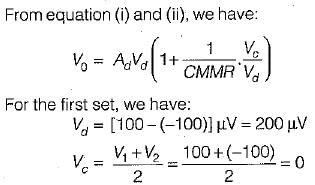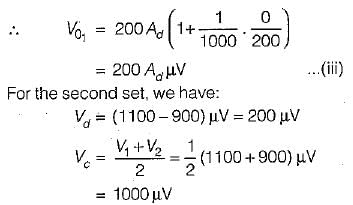Electronics and Communication Engineering (ECE) Exam > Electronics and Communication Engineering (ECE) Questions > A differential amplifier has (i) CMMR= 1000 a...
Start Learning for Free
A differential amplifier has (i) CMMR= 1000 and (ii) CMRR= 10000.
The first set of inputs is V1= 100 μV and V2, = -100μV.
The second set of inputs is V1= 1100 μV and V2 = 900 μV.
What is the percentage difference in output voltage obtained for the two sets of input voltages?
The first set of inputs is V1= 100 μV and V2, = -100μV.
The second set of inputs is V1= 1100 μV and V2 = 900 μV.
What is the percentage difference in output voltage obtained for the two sets of input voltages?
- a)1.0 %
- b)0.25 %
- c)0.5 %
- d)0.15 %
Correct answer is option 'C'. Can you explain this answer?
| FREE This question is part of | Download PDF Attempt this Test |
Verified Answer
A differential amplifier has (i) CMMR= 1000 and (ii) CMRR= 10000.The f...
we know that

Now,




From equation (iii) and (iv), the percentage difference in output voltage obtained for the two sets of input voltages

Most Upvoted Answer
A differential amplifier has (i) CMMR= 1000 and (ii) CMRR= 10000.The f...
And V2= 101, and the second set is V1= 1000 and V2= 1001. The common-mode voltage is 10V in both cases.
(i) CMMR= 1000 means that the amplifier can reject common-mode signals by a factor of 1000. In the first set of inputs, the common-mode voltage is 10V, so the output voltage due to the common-mode signal would be:
Vcm = (V1 + V2)/2 = (100 + 101)/2 = 100.5V
Since the differential voltage is only 1V, the differential gain of the amplifier is:
Ad = (Vout/Vin) = (V2 - V1)/Ad = 1/Ad
To eliminate the common-mode voltage, the differential gain should be:
Ad = CMMR/CMRR = 1000/10000 = 0.1
Therefore, the output voltage due to the differential signal would be:
Vout = Ad (V2 - V1) = 0.1 * 1 = 0.1V
The total output voltage would be:
Vout = Vcm + Vout_diff = 100.5V + 0.1V = 100.6V
(ii) In the second set of inputs, the differential voltage is 1V, and the common-mode voltage is still 10V. The differential gain of the amplifier should be:
Ad = CMMR/CMRR = 1000/10000 = 0.1
The output voltage due to the differential signal would be:
Vout_diff = Ad (V2 - V1) = 0.1 * 1 = 0.1V
The total output voltage would be:
Vout = Vcm + Vout_diff = 10V + 0.1V = 10.1V
Therefore, the common-mode rejection ratio of the amplifier is not sufficient to eliminate the common-mode voltage completely, and there is still a small output voltage due to the common-mode signal.
(i) CMMR= 1000 means that the amplifier can reject common-mode signals by a factor of 1000. In the first set of inputs, the common-mode voltage is 10V, so the output voltage due to the common-mode signal would be:
Vcm = (V1 + V2)/2 = (100 + 101)/2 = 100.5V
Since the differential voltage is only 1V, the differential gain of the amplifier is:
Ad = (Vout/Vin) = (V2 - V1)/Ad = 1/Ad
To eliminate the common-mode voltage, the differential gain should be:
Ad = CMMR/CMRR = 1000/10000 = 0.1
Therefore, the output voltage due to the differential signal would be:
Vout = Ad (V2 - V1) = 0.1 * 1 = 0.1V
The total output voltage would be:
Vout = Vcm + Vout_diff = 100.5V + 0.1V = 100.6V
(ii) In the second set of inputs, the differential voltage is 1V, and the common-mode voltage is still 10V. The differential gain of the amplifier should be:
Ad = CMMR/CMRR = 1000/10000 = 0.1
The output voltage due to the differential signal would be:
Vout_diff = Ad (V2 - V1) = 0.1 * 1 = 0.1V
The total output voltage would be:
Vout = Vcm + Vout_diff = 10V + 0.1V = 10.1V
Therefore, the common-mode rejection ratio of the amplifier is not sufficient to eliminate the common-mode voltage completely, and there is still a small output voltage due to the common-mode signal.
Attention Electronics and Communication Engineering (ECE) Students!
To make sure you are not studying endlessly, EduRev has designed Electronics and Communication Engineering (ECE) study material, with Structured Courses, Videos, & Test Series. Plus get personalized analysis, doubt solving and improvement plans to achieve a great score in Electronics and Communication Engineering (ECE).

|
Explore Courses for Electronics and Communication Engineering (ECE) exam
|

|
Similar Electronics and Communication Engineering (ECE) Doubts
A differential amplifier has (i) CMMR= 1000 and (ii) CMRR= 10000.The first set of inputs is V1= 100 μV and V2, = -100μV.The second set of inputs is V1= 1100 μV and V2 = 900 μV.What is the percentage difference in output voltage obtained for the two sets of input voltages?a)1.0 %b)0.25 %c)0.5 %d)0.15 %Correct answer is option 'C'. Can you explain this answer?
Question Description
A differential amplifier has (i) CMMR= 1000 and (ii) CMRR= 10000.The first set of inputs is V1= 100 μV and V2, = -100μV.The second set of inputs is V1= 1100 μV and V2 = 900 μV.What is the percentage difference in output voltage obtained for the two sets of input voltages?a)1.0 %b)0.25 %c)0.5 %d)0.15 %Correct answer is option 'C'. Can you explain this answer? for Electronics and Communication Engineering (ECE) 2024 is part of Electronics and Communication Engineering (ECE) preparation. The Question and answers have been prepared according to the Electronics and Communication Engineering (ECE) exam syllabus. Information about A differential amplifier has (i) CMMR= 1000 and (ii) CMRR= 10000.The first set of inputs is V1= 100 μV and V2, = -100μV.The second set of inputs is V1= 1100 μV and V2 = 900 μV.What is the percentage difference in output voltage obtained for the two sets of input voltages?a)1.0 %b)0.25 %c)0.5 %d)0.15 %Correct answer is option 'C'. Can you explain this answer? covers all topics & solutions for Electronics and Communication Engineering (ECE) 2024 Exam. Find important definitions, questions, meanings, examples, exercises and tests below for A differential amplifier has (i) CMMR= 1000 and (ii) CMRR= 10000.The first set of inputs is V1= 100 μV and V2, = -100μV.The second set of inputs is V1= 1100 μV and V2 = 900 μV.What is the percentage difference in output voltage obtained for the two sets of input voltages?a)1.0 %b)0.25 %c)0.5 %d)0.15 %Correct answer is option 'C'. Can you explain this answer?.
A differential amplifier has (i) CMMR= 1000 and (ii) CMRR= 10000.The first set of inputs is V1= 100 μV and V2, = -100μV.The second set of inputs is V1= 1100 μV and V2 = 900 μV.What is the percentage difference in output voltage obtained for the two sets of input voltages?a)1.0 %b)0.25 %c)0.5 %d)0.15 %Correct answer is option 'C'. Can you explain this answer? for Electronics and Communication Engineering (ECE) 2024 is part of Electronics and Communication Engineering (ECE) preparation. The Question and answers have been prepared according to the Electronics and Communication Engineering (ECE) exam syllabus. Information about A differential amplifier has (i) CMMR= 1000 and (ii) CMRR= 10000.The first set of inputs is V1= 100 μV and V2, = -100μV.The second set of inputs is V1= 1100 μV and V2 = 900 μV.What is the percentage difference in output voltage obtained for the two sets of input voltages?a)1.0 %b)0.25 %c)0.5 %d)0.15 %Correct answer is option 'C'. Can you explain this answer? covers all topics & solutions for Electronics and Communication Engineering (ECE) 2024 Exam. Find important definitions, questions, meanings, examples, exercises and tests below for A differential amplifier has (i) CMMR= 1000 and (ii) CMRR= 10000.The first set of inputs is V1= 100 μV and V2, = -100μV.The second set of inputs is V1= 1100 μV and V2 = 900 μV.What is the percentage difference in output voltage obtained for the two sets of input voltages?a)1.0 %b)0.25 %c)0.5 %d)0.15 %Correct answer is option 'C'. Can you explain this answer?.
Solutions for A differential amplifier has (i) CMMR= 1000 and (ii) CMRR= 10000.The first set of inputs is V1= 100 μV and V2, = -100μV.The second set of inputs is V1= 1100 μV and V2 = 900 μV.What is the percentage difference in output voltage obtained for the two sets of input voltages?a)1.0 %b)0.25 %c)0.5 %d)0.15 %Correct answer is option 'C'. Can you explain this answer? in English & in Hindi are available as part of our courses for Electronics and Communication Engineering (ECE).
Download more important topics, notes, lectures and mock test series for Electronics and Communication Engineering (ECE) Exam by signing up for free.
Here you can find the meaning of A differential amplifier has (i) CMMR= 1000 and (ii) CMRR= 10000.The first set of inputs is V1= 100 μV and V2, = -100μV.The second set of inputs is V1= 1100 μV and V2 = 900 μV.What is the percentage difference in output voltage obtained for the two sets of input voltages?a)1.0 %b)0.25 %c)0.5 %d)0.15 %Correct answer is option 'C'. Can you explain this answer? defined & explained in the simplest way possible. Besides giving the explanation of
A differential amplifier has (i) CMMR= 1000 and (ii) CMRR= 10000.The first set of inputs is V1= 100 μV and V2, = -100μV.The second set of inputs is V1= 1100 μV and V2 = 900 μV.What is the percentage difference in output voltage obtained for the two sets of input voltages?a)1.0 %b)0.25 %c)0.5 %d)0.15 %Correct answer is option 'C'. Can you explain this answer?, a detailed solution for A differential amplifier has (i) CMMR= 1000 and (ii) CMRR= 10000.The first set of inputs is V1= 100 μV and V2, = -100μV.The second set of inputs is V1= 1100 μV and V2 = 900 μV.What is the percentage difference in output voltage obtained for the two sets of input voltages?a)1.0 %b)0.25 %c)0.5 %d)0.15 %Correct answer is option 'C'. Can you explain this answer? has been provided alongside types of A differential amplifier has (i) CMMR= 1000 and (ii) CMRR= 10000.The first set of inputs is V1= 100 μV and V2, = -100μV.The second set of inputs is V1= 1100 μV and V2 = 900 μV.What is the percentage difference in output voltage obtained for the two sets of input voltages?a)1.0 %b)0.25 %c)0.5 %d)0.15 %Correct answer is option 'C'. Can you explain this answer? theory, EduRev gives you an
ample number of questions to practice A differential amplifier has (i) CMMR= 1000 and (ii) CMRR= 10000.The first set of inputs is V1= 100 μV and V2, = -100μV.The second set of inputs is V1= 1100 μV and V2 = 900 μV.What is the percentage difference in output voltage obtained for the two sets of input voltages?a)1.0 %b)0.25 %c)0.5 %d)0.15 %Correct answer is option 'C'. Can you explain this answer? tests, examples and also practice Electronics and Communication Engineering (ECE) tests.

|
Explore Courses for Electronics and Communication Engineering (ECE) exam
|

|
Suggested Free Tests
Signup for Free!
Signup to see your scores go up within 7 days! Learn & Practice with 1000+ FREE Notes, Videos & Tests.
























